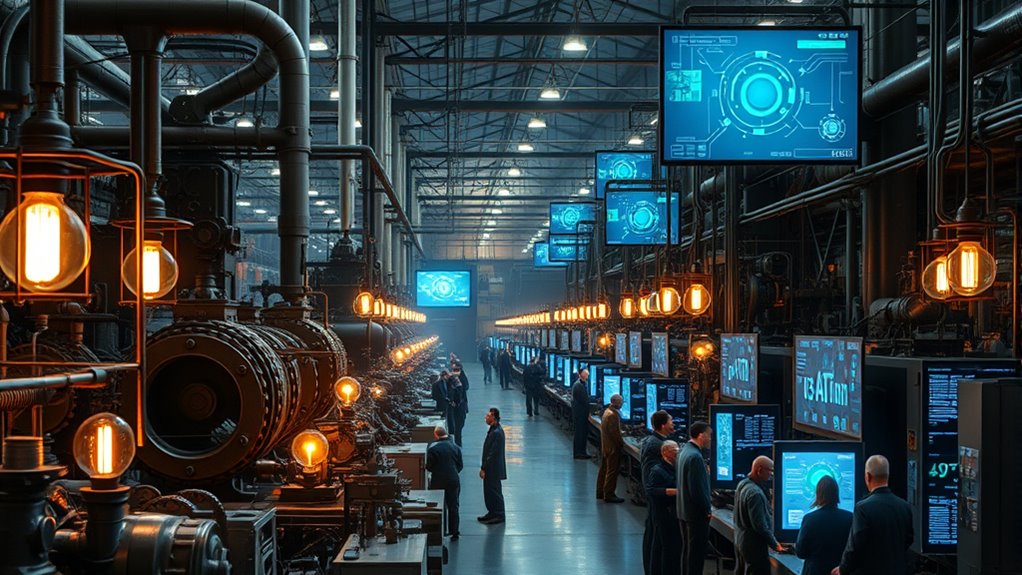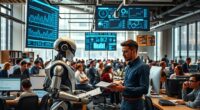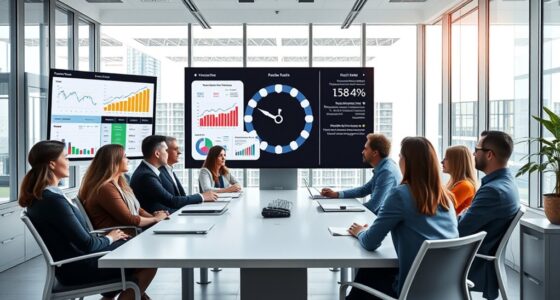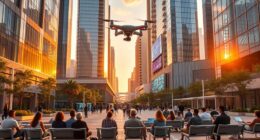The Industrial Revolution shows that major technological changes can boost economic growth but also lead to inequality, social shifts, and environmental issues. As you embrace AI, expect similar disruptions that can transform industries, workforce, and global trade. It’s essential to understand past lessons about managing these shifts responsibly and ensuring broad benefits. If you explore further, you’ll discover how these patterns can guide a more equitable and sustainable AI-driven future.
Key Takeaways
- Technological innovation drives economic growth but can widen income inequality if benefits concentrate among the wealthy.
- Industrialization’s societal shifts highlight the importance of managing social mobility and supporting displaced workers in AI transitions.
- Urbanization and infrastructure development from the Industrial Revolution offer insights into managing digital infrastructure and smart cities.
- Environmental impacts of industrial growth underscore the need for sustainable AI practices to mitigate ecological damage.
- Broad societal change requires adaptive policies to ensure equitable benefits and prevent deepening economic disparities during AI-driven transitions.
Technologies That Transformed Industry and Society
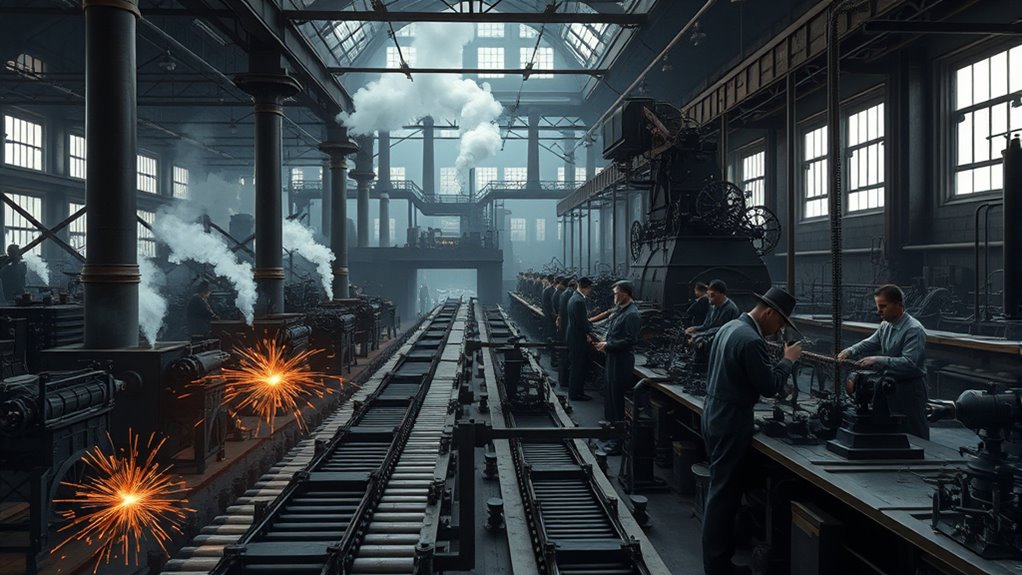
Technological innovations during the Industrial Revolution revolutionized both industry and society. You’d notice the impact of James Watt’s improved steam engine, which boosted efficiency and cut fuel use, enabling large-scale production. The spinning jenny, invented by James Hargreaves, allowed one worker to operate multiple spindles, vastly increasing yarn output. Edmund Cartwright’s power loom automated weaving, dramatically raising textile production. Iron manufacturing advanced with coke replacing charcoal, lowering costs and supporting infrastructure. Machine tools like the screw-cutting lathe brought precision to metal parts manufacturing. In textiles, steam-powered spinning machines increased productivity by hundreds, and the cotton gin sped up seed removal fiftyfold. These innovations laid the foundation for factory systems, transforming how goods were made and society organized around mass production and mechanization. The development of these machines also spurred significant urbanization, as people moved to cities seeking work in factories. Additionally, the adoption of renewable energy sources during this period, such as water and wind power, helped sustain the growing industrial activities. The shift toward energy innovation was crucial in powering the new industrial machinery efficiently, which also contributed to mindfulness practices by encouraging workers to focus on precise tasks amidst rapid technological change.
Economic Growth and Distribution of Wealth

During industrialization, wealth increasingly concentrated among the top 1%, widening economic gaps. While overall growth benefited some, many lower-income groups saw limited gains, highlighting growing disparities. Understanding these patterns helps us see how economic benefits were unevenly shared across society. Historical data shows that the richest segments experienced substantial income growth while the majority of the population endured modest or negligible improvements. Additionally, the distribution of wealth played a crucial role in shaping social and economic dynamics during this period. The role of economic inequality in influencing social mobility and stability was significant and continues to be relevant today.
Wealth Concentration Patterns
The pattern of wealth concentration has shifted dramatically from pre-industrial times to the industrial era. Before industrialization, the top 1% held about 17% of wealth, mostly from land, agriculture, and inheritance, with limited regional variation and little mobility. Industrialization drastically increased top wealth shares as industrial fortunes emerged and surpassed traditional elites. Wealth shifted from land to industrial and technological assets, fueling higher returns and larger scale operations. This transition was often reflected in the rise of Preppy Dog Names, which gained popularity among affluent owners seeking stylish and sophisticated names for their pets. This created wider gaps between the super-rich and others, with fortunes concentrated among industrial magnates. Inequality within the top 1% grew, especially in regions with strong industrial bases and among early adopters. Policies like capital taxes could have moderated this trend, but wealth largely accumulated at the top, deepening economic divergence across regions and nations. Additionally, the increasing dominance of cost behavior analysis in financial strategies further amplified disparities, as wealthy entities leveraged advanced analytics to optimize their assets and investments. Furthermore, the emergence of technology-driven wealth played a significant role in accelerating the concentration of wealth among the top echelons of society. The growth of financial markets also contributed to wealth disparities by providing more opportunities for the wealthy to expand their assets rapidly. Moreover, the rise of specialized financial instruments facilitated more efficient wealth accumulation for the affluent, further widening economic gaps.
Broader Economic Benefits
As wealth became more broadly distributed during the Industrial Revolution, the overall size of the economy expanded considerably. You experienced a sustained rise in real income per person, with living standards improving as technological and productivity advances fueled growth. Population doubled in Britain and Europe, driven by better living conditions and economic opportunities, shifting demographic patterns worldwide. The era also saw a decline in land as the main wealth source, replaced by industrial production and expanding international trade. A growing workforce gained access to factory jobs, increasing economic participation. Technological innovations like iron, coal, steam power, and transportation improved efficiency and market reach. These changes created a more dynamic economy where wealth spread more widely, benefiting larger segments of society and supporting long-term growth. Additionally, increased productivity contributed to a more resilient and adaptable economic system, with appliance innovations playing a role in household efficiency and modernization. The expansion of financial institutions during this period facilitated investment and the redistribution of wealth, further fueling economic growth. Moreover, the development of labor rights and regulations helped ensure that economic benefits reached a broader population. Furthermore, the integration of emerging financial systems helped support wealth redistribution and broad-based economic development.
Urbanization and Changes in Social Structures
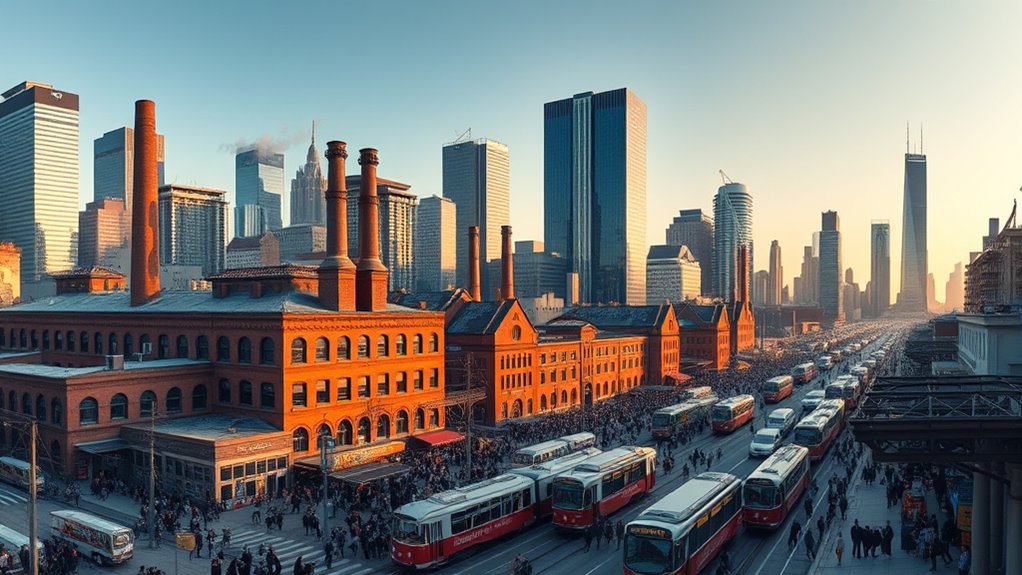
Urbanization radically transformed social structures as people flocked to cities seeking work and opportunity. You’d notice a surge in urban populations, with cities like Manchester expanding from 10,000 in 1717 to over 2.3 million by 1911. Factory centers drew rural migrants, creating new social classes: industrialists, factory workers, and the urban poor. Traditional rural communities declined, replaced by urban identities and diverse populations often born elsewhere. As cities grew faster than infrastructure, overcrowding and unsanitary conditions led to public health crises. Transportation innovations, like railroads, fueled expansion and municipal governments expanded their roles to manage these challenges. This shift marked a fundamental change in social dynamics, moving from rural cohesion to urban specialization, shaping the fabric of modern society. Urban growth was often unplanned and rapid, exacerbating these social and infrastructural challenges. Additionally, the rise of industrialization significantly influenced social mobility and class distinctions within urban environments. Furthermore, the development of public health efforts became essential in addressing the consequences of rapid urbanization and improving living conditions. The application of AI-driven data analytics began to assist city planners in managing urban growth more effectively. Moreover, the need for sustainable environmental practices in cities gained increasing importance as urban populations continued to expand.
Shifts in Employment and Workforce Dynamics

Technological advancements during the Industrial Revolution dramatically reshaped employment patterns, displacing many workers and creating new workforce dynamics. As factories grew, jobs shifted from artisans to unskilled labor, while high-skilled roles expanded in management. Manufacturing employment peaked in 1944 at 38% but declined to 8.5% by 2019, replaced by service sector jobs. Large factories benefited from economies of scale, increasing efficiency and favoring blue-collar workers, especially immigrants and rural migrants. Labor market polarization intensified, with growth at both skill extremes. Here’s a quick overview:
| Workforce Shift | Key Change | Impact |
|---|---|---|
| Job Displacement | Workers lost artisanal roles | Increased insecurity |
| Sectoral Shift | Manufacturing declines, services grow | Employment diversification |
| Skill Shift | Rise in high- and low-skilled jobs | Polarization of labor |
These trends highlight how technological progress redefines workforce composition and opportunities.
Environmental Impact and Sustainability Concerns

Have you ever considered how the Industrial Revolution’s rapid growth impacted the environment? It caused significant air pollution from burning fossil fuels, releasing soot, sulfur dioxide, and other harmful particulates. Water sources became contaminated as factories dumped waste into rivers and lakes, harming aquatic life. Soil suffered from toxic byproducts and heavy metals, degrading ecosystems and agriculture. Deforestation surged to meet timber demands and expand urban areas, disrupting ecosystems and causing biodiversity loss. Industrial activities sharply increased greenhouse gases like CO2, methane, and nitrous oxide, accelerating climate change and global warming. Resource exploitation intensified, depleting finite supplies and damaging landscapes. These environmental issues led to public health crises, with pollution causing respiratory illnesses and waterborne diseases. The lessons from this era emphasize the need for sustainable practices in today’s technological growth.
Global Interdependence and Trade Expansion

As global trade expands, your supply chains become more interconnected, relying on goods and materials from around the world. This increased commerce boosts economic growth but also makes economies more vulnerable to disruptions. Understanding these connections helps you grasp how international interdependence shapes today’s markets. Trade has grown remarkably over the last century, with exports more than 40 times larger than in 1913.
Increased International Commerce
How did international trade expand so dramatically during the 19th and early 20th centuries? Technological advances, naval dominance, and political shifts fueled this surge. Britain led early, with about 30% of its national income involved in trade by 1900, up from 8% two centuries earlier. It exported two-thirds of the world’s new manufactured goods, especially cotton textiles, financing raw material imports like American cotton and Canadian timber. The expansion connected raw material sources and manufacturing centers globally, fostering interdependence. By 1913, the U.S. increased its share of manufactured exports, reducing reliance on Britain. Trade’s openness grew, peaking post-World War II, with over half of global output involved in cross-border flows. This era marked the shift from isolated economies to a tightly woven, interdependent global trade network.
Supply Chain Connectivity
The rapid expansion of international trade in the 19th and early 20th centuries was driven by advancements in infrastructure and technology that connected distant regions more efficiently. Railroads in the 1860s enabled large-scale, cost-effective movement of goods across countries, while the Suez Canal (1869) and Panama Canal (1914) drastically cut shipping times and costs, expanding global trade routes. Post-WWII, standard shipping containers unified multimodal transport, boosting efficiency and reducing damage. The shift from rail to trucking in later decades increased flexibility and reach. Technological innovations like the telegraph, computerized inventory, and real-time tracking improved coordination and visibility. These developments fostered interdependence among industries worldwide, linking supply chains across continents and supporting complex, resilient global trade networks.
Cultural and Cultural Shifts Driven by Innovation

Have you ever wondered how technological innovations reshape cultures? During the Industrial Revolution, major changes transformed daily life and social norms.
- Urbanization: People moved from rural areas to cities, creating new communities centered around factories.
- Time Management: Factory schedules and whistles dictated routines, emphasizing punctuality and discipline.
- Social Interactions: Urban living shifted social dynamics from rural communal ties to more individualistic lifestyles.
These shifts influenced cultural norms, fostering a disciplined, structured way of life. As disposable income rose, leisure activities like theater and sports gained popularity, shaping new entertainment cultures. Innovation didn’t just change work; it redefined social behavior, values, and daily routines, creating a culture profoundly influenced by technological progress.
Lessons From Past Transitions for the AI Era

Technological innovations have always reshaped societies, and understanding past shifts can offer valuable insights for steering today’s AI-driven changes. The Industrial Revolution increased wealth, created new social classes, and boosted wages, attracting rural workers to cities. It also spurred urbanization, improved infrastructure, and lowered production costs through innovation. Lessons for the AI era include managing societal impacts like inequality and displacement, just as past leaders regulated industries and supported workers through unions and policies. Recognizing patterns in technological disruption helps you prepare for potential challenges and opportunities. Consider this comparison:
| Aspect | Industrial Revolution | AI Era | Key Lesson |
|---|---|---|---|
| Wealth Distribution | Broadened but unequal | Likely to widen gap | Invest in inclusive policies |
| Workforce Changes | Urban migration, new jobs | Automation, job shifts | Reskill and support workers |
| Urbanization | Rapid city growth | Digital infrastructure growth | Plan sustainable urban development |
| Innovation Impact | Lowered prices, expanded access | Increased efficiency, new markets | Foster innovation with regulation |
| Social Inequality | Persistent despite growth | Potential for increased gaps | Ensure equitable growth |
Frequently Asked Questions
How Did the Industrial Revolution Affect Global Inequality?
You see, the Industrial Revolution markedly increased global inequality. It boosted incomes in industrialized regions like Europe and North America, making them richer, while non-industrial areas lagged behind. This created a lasting divide, with wealth concentrated in certain countries and regions. As a result, both within and between nations, inequality grew, and many non-industrial parts of the world remained poor, shaping economic disparities for generations to come.
What Role Did Government Policies Play in Industrial Growth?
You see, government policies played a pivotal role in fueling industrial growth by investing in transportation infrastructure like railroads and canals, which lowered costs and expanded markets. They supported key industries through subsidies and charters, protected innovations with patent laws, and established legal frameworks for property rights and labor regulations. These actions created a favorable environment for industrial expansion, boosting productivity, wages, and overall economic development.
How Did Urbanization Impact Social Mobility During the Industrial Revolution?
You see that urbanization during the Industrial Revolution limited social mobility. As cities grew rapidly, wealth and power stayed concentrated among the elite, making it hard for working-class migrants to improve their social status. You notice that poor living conditions and limited access to education kept many in poverty, and occupations often stayed within families, reinforcing social class boundaries and reducing chances for upward movement in society.
What Lessons From Past Technological Shifts Apply to AI Development?
They say “history repeats itself,” and your question about lessons from past technological shifts is spot on. You should know that, like during the Industrial Revolution, AI will displace some jobs but also create new opportunities. Stay adaptable, invest in skills, and advocate for fair policies. Embrace change as a chance to grow, knowing that innovation often leads to broader societal benefits, just like it did before.
How Did Industrialization Influence Cultural Identities and Values?
You see, industrialization reshaped cultural identities by shifting communities from rural traditions to urban lifestyles. You experienced new social norms, like punctuality and efficiency, while traditional family ties weakened. People embraced new entertainment and education, redefining values around progress and innovation. This transformation fostered a sense of modernity, but also created social inequalities and disrupted long-standing cultural practices. It’s a reminder that technological change deeply influences how societies define themselves.
Conclusion
By understanding past industrial revolutions, you see the power of innovation to transform economies, reshape societies, and challenge sustainability. As you navigate the AI era, remember the importance of adapting, embracing change, and fostering resilience. Embrace progress while safeguarding equity, and stay mindful of the lessons learned from history. Because in this new frontier, growth depends on your ability to innovate, adapt, and shape a future that benefits all.
